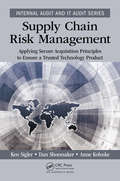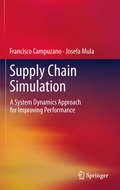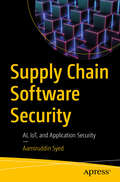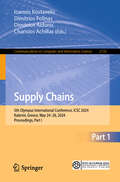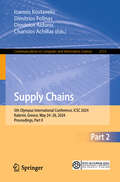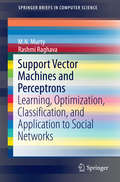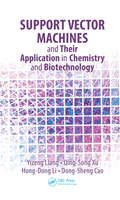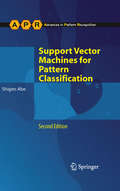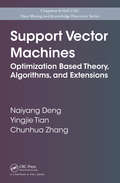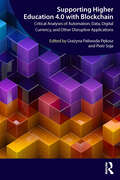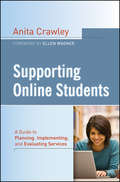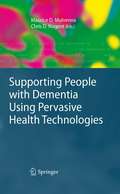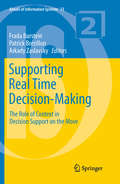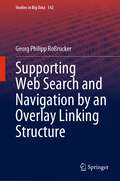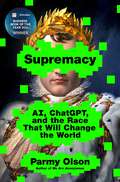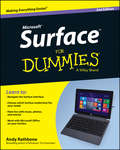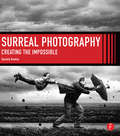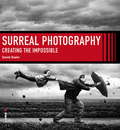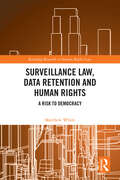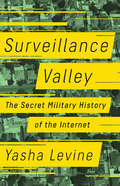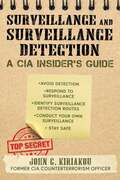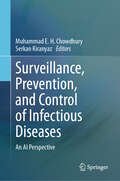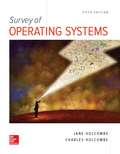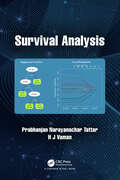- Table View
- List View
Supply Chain Risk Management: Applying Secure Acquisition Principles to Ensure a Trusted Technology Product (Internal Audit and IT Audit)
by Dan Shoemaker Anne Kohnke Ken SiglerThe book presents the concepts of ICT supply chain risk management from the perspective of NIST IR 800-161. It covers how to create a verifiable audit-based control structure to ensure comprehensive security for acquired products. It explains how to establish systematic control over the supply chain and how to build auditable trust into the products and services acquired by the organization. It details a capability maturity development process that will install an increasingly competent process and an attendant set of activities and tasks within the technology acquisition process. It defines a complete and correct set of processes, activities, tasks and monitoring and reporting systems.
Supply Chain Simulation
by Francisco Campuzano Josefa MulaSupply Chain Simulation allows readers to practice modeling and simulating a multi-level supply chain. The chapters are a combination of the practical and the theoretical, covering: knowledge of simulation methods and techniques,the conceptual framework of a typical supply chain,the main concepts of system dynamics, anda set of practice problems with their corresponding solutions.The problem set includes illustrations and graphs relating to the simulation results of the Vensim® program, the main code of which is also provided. The examples used are a valuable simulation tool that can be modified and extended according to user requirements. The objective of Supply Chain Simulation is to meet the demands of supply chain simulation or similar courses taught at the postgraduate level. The "what if" analysis recreates different simulation scenarios to improve the decision-making process in terms of supply chain performance, making the book useful not only for postgraduate students, but also for industrial practitioners.
Supply Chain Software Security: AI, IoT, and Application Security
by Aamiruddin SyedDelve deep into the forefront of technological advancements shaping the future of supply chain safety and resilience. In an era where software supply chains are the backbone of global technology ecosystems, securing them against evolving threats has become mission critical. This book offers a comprehensive guide to understanding and implementing next-generation strategies that protect these intricate networks from most pressing risks. This book begins by laying the foundation of modern software supply chain security, exploring the shifting threat landscape and key technologies driving the future. Delve into the heart of how AI and IoT are transforming supply chain protection through advanced predictive analytics, real-time monitoring, and intelligent automation. Discover how integrating application security practices within your supply chain can safeguard critical systems and data. Through real-world case studies and practical insights, learn how to build resilient supply chains equipped to defend against sophisticated attacks like dependency confusion, backdoor injection, and adversarial manipulation. Whether you’re managing a global software operation or integrating DevSecOps into your CI/CD pipelines, this book offers actionable advice for fortifying your supply chain end-to-end. You Will: Learn the role of AI and machine learning in enhancing supply chain threat detection Find out the best practices for embedding application security within the supply chain lifecycle Understand how to leverage IoT for secure, real-time supply chain monitoring and control Who Is This Book For The target audience for a book would typically include professionals and individuals with an interest or involvement in cloud-native application development and DevOps practices. It will cover fundamentals of cloud-native architecture, DevOps principles, and provide practical guidance for building and maintaining scalable and reliable applications in a cloud-native environment. The book's content will cater to beginner to intermediate level professionals seeking in-depth insights.
Supply Chains: 5th Olympus International Conference, ICSC 2024, Katerini, Greece, May 24–26, 2024, Proceedings, Part I (Communications in Computer and Information Science #2110)
by Dimitrios Aidonis Charisios Achillas Ioannis Kostavelis Dimitrios FolinasThis two-volume set constitutes the refereed proceedings of the 5th Olympus International Conference, ICSC 2024, held in Katerini, Greece, during May 24–26, 2024. The 51 full papers in this volume were carefully reviewed and selected from a total of 92 submissions. The primary objective of 5th Olympus ICSC is to offer an international platform for the presentation and publication of the latest scientific research findings in the field of Supply Chain Management. This conference provides valuable opportunities for delegates to exchange innovative ideas, establish research and business connections, and foster global partnerships for potential collaborations. We sincerely anticipate that this conference will significantly contribute to the advancement of knowledge in relevant scientific and academic domains.
Supply Chains: 5th Olympus International Conference, ICSC 2024, Katerini, Greece, May 24–26, 2024, Proceedings, Part II (Communications in Computer and Information Science #2111)
by Dimitrios Aidonis Charisios Achillas Ioannis Kostavelis Dimitrios FolinasThis two-volume set constitutes the refereed proceedings of the 5th Olympus International Conference, ICSC 2024, held in Katerini, Greece, during May 24–26, 2024. The 51 full papers in this volume were carefully reviewed and selected from a total of 92 submissions. The primary objective of 5th Olympus ICSC is to offer an international platform for the presentation and publication of the latest scientific research findings in the field of Supply Chain Management. This conference provides valuable opportunities for delegates to exchange innovative ideas, establish research and business connections, and foster global partnerships for potential collaborations. We sincerely anticipate that this conference will significantly contribute to the advancement of knowledge in relevant scientific and academic domains.
Support Vector Machines and Perceptrons
by M. N. Murty Rashmi RaghavaThis work reviews the state of the art in SVM and perceptron classifiers. A Support Vector Machine (SVM) is easily the most popular tool for dealing with a variety of machine-learning tasks, including classification. SVMs are associated with maximizing the margin between two classes. The concerned optimization problem is a convex optimization guaranteeing a globally optimal solution. The weight vector associated with SVM is obtained by a linear combination of some of the boundary and noisy vectors. Further, when the data are not linearly separable, tuning the coefficient of the regularization term becomes crucial. Even though SVMs have popularized the kernel trick, in most of the practical applications that are high-dimensional, linear SVMs are popularly used. The text examines applications to social and information networks. The work also discusses another popular linear classifier, the perceptron, and compares its performance with that of the SVM in different application areas. >
Support Vector Machines and Their Application in Chemistry and Biotechnology
by Yizeng Liang Qing-Song Xu Hong-Dong Li Dong-Sheng CaoSupport vector machines (SVMs) are used in a range of applications, including drug design, food quality control, metabolic fingerprint analysis, and microarray data-based cancer classification. While most mathematicians are well-versed in the distinctive features and empirical performance of SVMs, many chemists and biologists are not as familiar wi
Support Vector Machines for Pattern Classification
by Shigeo AbeA guide on the use of SVMs in pattern classification, including a rigorous performance comparison of classifiers and regressors. The book presents architectures for multiclass classification and function approximation problems, as well as evaluation criteria for classifiers and regressors. Features: Clarifies the characteristics of two-class SVMs; Discusses kernel methods for improving the generalization ability of neural networks and fuzzy systems; Contains ample illustrations and examples; Includes performance evaluation using publicly available data sets; Examines Mahalanobis kernels, empirical feature space, and the effect of model selection by cross-validation; Covers sparse SVMs, learning using privileged information, semi-supervised learning, multiple classifier systems, and multiple kernel learning; Explores incremental training based batch training and active-set training methods, and decomposition techniques for linear programming SVMs; Discusses variable selection for support vector regressors.
Support Vector Machines: Optimization Based Theory, Algorithms, and Extensions (Chapman & Hall/CRC Data Mining and Knowledge Discovery Series)
by Yingjie Tian Chunhua Zhang Naiyang DengSupport Vector Machines: Optimization Based Theory, Algorithms, and Extensions presents an accessible treatment of the two main components of support vector machines (SVMs)-classification problems and regression problems. The book emphasizes the close connection between optimization theory and SVMs since optimization is one of the pillars on which
Supporting Higher Education 4.0 with Blockchain: Critical Analyses of Automation, Data, Digital Currency, and Other Disruptive Applications
by Grażyna Paliwoda-Pękosz Piotr SojaThis book explores the current and future impacts of blockchain technologies, such as cryptocurrency, on the education system. Blockchain is a disruptive technology based on a shared, distributed ledger, where transactions are registered by consensus in a network of peers, using cryptographic mechanisms that render the records virtually immutable and, ideally, enable transparency, auditability, and resilience. What role, then, could it play in fostering transformative approaches such as student-centred teaching and learning, distributed learning environments, and lifelong learning? This book provides essential perspectives into blockchain applications and challenges within education and offers a broader view of blockchain technology against existing information and communication technologies used in education. Spanning the effects on institutions, students, and the labor market, these chapters offer critical reviews and analyses of current research, practical first-hand applications of blockchain in education, and original conceptual models.
Supporting Online Students
by Anita CrawleySupporting Online Students shows how effective and efficiently delivered support services improve academic success and course retention for online learners. Drawing on a decade's worth of research, Crawley describes the scope of services that should be made available to online students, from admissions and registration to advising and student engagement. The book includes guidelines and standards for these services as outlined by half a dozen national professional organizations, as well as planning and implementation, innovative practices, and specialized services needed by particular online student groups.
Supporting People with Dementia Using Pervasive Health Technologies
by Chris D. Nugent Maurice D MulvennaInformation and communication technologies can provide new paradigms in healthcare provision. In particular, new Pervasive Healthcare technologies can revolutionise the dynamics of healthcare, enabling people to remain at home for longer, at lower costs to health and welfare organisations. This book reveals how pervasive healthcare technologies can be designed in conjunction with users and carers, as well as exploring the application of novel methods and technologies.
Supporting Real Time Decision-Making
by Frada Burstein Arkady Zaslavsky Patrick BrézillonThis volume of Annals of Information Systems will acknowledge the twentieth anniversary of the founding of the International Society for Decision Support Systems (ISDSS) by documenting some of the current best practices in teaching and research and envisioning the next twenty years in the decision support systems field. The volume is intended to complement existing DSS literature by offering an outlet for thoughts and research particularly suited to the theme of describing the next twenty years in the area of decision support. Several subthemes are planned for the volume. One subtheme draws on the assessments of internationally known DSS researchers to evaluate where the field has been and what has been accomplished. A second subtheme of the volume will be describing the current best practices of DSS research and teaching efforts. A third subtheme will be an assessment by top DSS scholars on where the DSS discipline needs to focus in the future. The tone of this volume is one of enthusiasm for the potential contributions to come in the area of DSS; contributions that must incorporate an understanding of what has been accomplished in the past, build on the best practices of today, and be integrated into future decision making practices.
Supporting Web Search and Navigation by an Overlay Linking Structure (Studies in Big Data #142)
by Georg Philipp RoßruckerSearch and navigation in hyperlinked networks have been subjects of research since the Internet emerged. Due to its incompleteness in terms of linking related content, the existing linking structure of the Web and similar networks cannot be utilized as a searchable index without prior application of suitable crawling strategies and content categorization. Following the example of sitemaps, a map-like extension to the existing link structure of the network is proposed that creates additional contextual links. For this, a concept and algorithms are devised that allow the creation of contextual cluster files, to which documents are assigned and between which semantically relevant links are established. The resulting WebMap covers all searchable resources on the original network in a contextual overlay network and enables new search and navigation approaches.
Supremacy: AI, ChatGPT, and the Race that Will Change the World
by Parmy OlsonWINNER OF THE THE FINANCIAL TIMES AND SCHRODERS 2024 BUSINESS BOOK OF THE YEAR AWARDIn November of 2022, a webpage was posted online with a simple text box. It was an AI chatbot called ChatGPT, and was unlike any app people had used before. It was more human than a customer service agent, more convenient than a Google search. Behind the scenes, battles for control and prestige between the world’s two leading AI firms, OpenAI and DeepMind, who now steers Google's AI efforts, has remained elusive - until now.In Supremacy, Olson, tech writer at Bloomberg, tells the astonishing story of the battle between these two AI firms, their struggles to use their tech for good, and the hazardous direction they could go as they serve two tech Goliaths whose power is unprecedented in history. The story focuses on the continuing rivalry of two key CEOs at the center of it all, who cultivated a religion around their mission to build god-like super intelligent machines: Sam Altman, CEO of OpenAI, and Demis Hassabis, the CEO of DeepMind. Supremacy sharply alerts readers to the real threat of artificial intelligence that its top creators are ignoring: the profit-driven spread of flawed and biased technology into industries, education, media and more. With exclusive access to a network of high-ranking sources, Parmy Olson uses her 13 years of experience covering technology to bring to light the exploitation of the greatest invention in human history, and how it will impact us all.
Surface For Dummies
by Andy RathboneMake Microsoft's Surface work--and play--just the way you want it toMicrosoft's Surface tablet has the features and personality you're looking for, with a robust environment for business computing that doesn't skimp on fun. Surface for Dummies, 2nd Edition explains how Windows 8.1 Pro and Windows RT differ, and helps you decide which Surface model is best for you. Step by step, this book walks you through both the hardware and software features of the Surface, including the touch cover and type cover, Windows RT and Windows 8.1 Pro operating systems, and the coveted Office Home & Student 2013 software suite that's bundled with the Surface. Written by bestselling author Andy Rathbone, this easy-to-access book is filled with information on how to use the tablet, figure out the operating system, navigate the app environment, and take advantage of your exciting new Surface.The book is your personal guide to one the fastest, sleekest, and most powerful tablets on the market. Surface is designed to be thin, light, and with hours of battery life so you can power through your day with ease. With this handy reference, you'll be able to make quick work of your to-do list and have fun all at the same time!Create: release your inner artist with Fresh Paint, a touch-based art appShare: Multiple accounts offer privacy and security so you can share your Surface, but not your stuffEnjoy: Snap apps side by side to multi-task on the vivid HD screenDiscover: New apps in the Windows Store so you can work efficiently and get more doneWith Surface For Dummies, 2nd Edition you can navigate and enhance your entire Surface experience!
Surface- and Groundwater Quality Changes in Periods of Water Scarcity
by Miloš GregorThis thesis deals with the evaluation of surface and groundwater quality changes in the periods of water scarcity in river catchment areas. The work can be divided into six parts. Existing methods of drought assessment are discussed in the first part, followed by the brief description of the software package HydroOffice, designed by the author. The software is dedicated to analysis of hydrological data (separation of baseflow, parameters of hydrological drought estimation, recession curves analysis, time series analysis). The capabilities of the software are currently used by scientist from more than 30 countries around the world. The third section is devoted to a comprehensive regional assessment of hydrological drought on Slovak rivers, followed by evaluation of the occurrence, course and character of drought in precipitation, discharges, base flow, groundwater head and spring yields in the pilot area of the Nitra River basin. The fifth part is focused on the assessment of changes in surface and groundwater quality during the drought periods within the pilot area. Finally, the results are summarized and interpreted, and rounded off with an outlook to future research.
Surreal Photography: Creating The Impossible
by Daniela BowkerSurreal digital photography is not only an enjoyable extension of many enthusiast’s repertoire, but is has firmly established a foothold in the world of art. This book reveals the latest developments in the field and demystifies the techniques used by modern surreal photographers, whether they favor SOOC (straight out of the camera) or sophisticated digital manipulations. Breaking down the shooting and editing process for any reader to follow and emulate, this book provides step-by-step instructions for creating extraordinary scenes. With contributions from numerous artists—including Natalie Dybisz, Jon Jacobsen and Dariusz Klimczak— readers will be able to explore many different artistic styles from impossible landscapes to unsettling portraits.
Surreal Photography: Creating the Impossible
by Daniela BowkerEver since Man Ray imposed the sound holes of a violin onto his model's back, photographers have been enthusiastic practitioners of surreal art. Now with the advent of high-quality digital photo-manipulation the possibilities for creativity have become infinite. This book reveals the latest techniques in the field of surreal photography and features art from a host of the very best modern surreal photographers.- Breaks down the shooting and editing process so any photographer can make their own impossible images- With processing walkthroughs from contributing artists including Natalie Dybisz, Julie de Waroquier and Sarolta Bán- Step-by-step instructions for creating extraordinary scenes- Covers many different styles, from impossible landscapes to unsettling portraits
Surveillance Law, Data Retention and Human Rights: A Risk to Democracy (Routledge Research in Human Rights Law)
by Matthew WhiteThis book analyses the compatibility of data retention in the UK with the European Convention on Human Rights (ECHR). The increase in the use of modern technology has led to an explosion of generated data and, with that, a greater interest from law enforcement and intelligence agencies. In the early 2000s, data retention laws were introduced into the UK, and across the European Union (EU). This was met by domestic challenges before national courts, until a seminal ruling by the Court of Justice in the European Union (CJEU) ruled that indiscriminate data retention was incompatible with EU law. Since then, however, the CJEU has revised its position and made certain concessions, particularly under the guise of national security. This book focuses on data retention in the UK with the principal aim of examining compatibility with the ECHR. This is explored through a variety of ways including providing an account of democracy and why secret surveillance poses a threat to it, a history of data retention, assessing the seriousness that data retention poses to fundamental rights, the collection of rights that are affected by data retention which are crucial for a functioning democracy, the implications of who can be obligated to retain (and what to retain), the idea that data retention is a form of surveillance and ultimately, with all things considered, whether this is compatible with the ECHR. The work will be an invaluable resource for students, academics, researchers and policy-makers working in the areas of privacy, human rights law and surveillance.
Surveillance Valley: The Secret Military History of the Internet
by Yasha LevineThe internet is the most effective weapon the government has ever built.In this fascinating book, investigative reporter Yasha Levine uncovers the secret origins of the internet, tracing it back to a Pentagon counterinsurgency surveillance project.A visionary intelligence officer, William Godel, realized that the key to winning the war in Vietnam was not outgunning the enemy, but using new information technology to understand their motives and anticipate their movements. This idea--using computers to spy on people and groups perceived as a threat, both at home and abroad--drove ARPA to develop the internet in the 1960s, and continues to be at the heart of the modern internet we all know and use today. As Levine shows, surveillance wasn't something that suddenly appeared on the internet; it was woven into the fabric of the technology.But this isn't just a story about the NSA or other domestic programs run by the government. As the book spins forward in time, Levine examines the private surveillance business that powers tech-industry giants like Google, Facebook, and Amazon, revealing how these companies spy on their users for profit, all while doing double duty as military and intelligence contractors. Levine shows that the military and Silicon Valley are effectively inseparable: a military-digital complex that permeates everything connected to the internet, even coopting and weaponizing the antigovernment privacy movement that sprang up in the wake of Edward Snowden.With deep research, skilled storytelling, and provocative arguments, Surveillance Valley will change the way you think about the news--and the device on which you read it.
Surveillance and Surveillance Detection: A CIA Insider's Guide
by John KiriakouHave you ever thought you were being followed or watched? Have you ever needed to follow or observe someone and not be seen?In the world of espionage, surveillance and surveillance detection are a way of life. It is the job of every CIA operations officer to make sure he or she is not under surveillance—that is, being followed to the commission of an &“operational act.&” It is also the job of every CIA operations officer to surveil his own targets, whether they are terrorists or terrorist suspects, foreign intelligence officers, hostile actors, or even sometimes his own agents for vetting purposes. In everyday life, many people from all walks of life need to know how to perform similar operations. Whether avoiding a stalker, checking up on an unfaithful partner, or just securing one&’s own privacy, a working knowledge of modern surveillance and surveillance detection techniques is a critical skill to possess. And there is nobody better to teach that skill than someone trained by the CIA.From former CIA counterterrorism officer John C. Kiriakou, Surveillance and Surveillance Detection: A CIA Insider's Guide takes you through the CIA's surveillance and surveillance detection program. It will teach you to apply CIA surveillance techniques to your own everyday life. You&’ll learn how to stay safe, to ensure your privacy, and to keep the honest people honest—the CIA way.
Surveillance, Prevention, and Control of Infectious Diseases: An AI Perspective
by Serkan Kiranyaz Muhammad E. H. ChowdhuryThis is a pioneering book that delves into the intersection of artificial intelligence (AI) and healthcare, specifically focusing on the detection and prevention of infectious diseases. Authored by leading experts in the field, this book offers a comprehensive overview of the latest advancements, challenges, and applications of AI in combating infectious diseases. With a unique emphasis on big data, wearable data, and computer vision, the book presents original research works that showcase innovative approaches to leveraging AI for disease surveillance, screening, and severity stratification. Through a combination of review chapters summarizing the current state of the field and novel applications of AI technology, readers gain valuable insights into the potential of AI in addressing major life-threatening infectious diseases identified by the UN Sustainable Development Goal 3. The book's structure ensures a balanced blend of theoretical foundations and practical applications, making it accessible to both researchers and healthcare professionals. By exploring cutting-edge methodologies and case studies, the book equips readers with the knowledge and tools needed to harness the power of AI in the fight against infectious diseases, ultimately contributing to global efforts to improve public health outcomes. With its interdisciplinary approach and focus on AI-driven solutions, " Surveillance, prevention, and control of infectious diseases: An AI perspective" serves as an invaluable resource for researchers, practitioners, and policymakers seeking to stay abreast of the latest developments in this rapidly evolving field. Whether exploring the role of wearable devices in disease monitoring or examining the potential of computer vision for early detection, this book offers a comprehensive overview of AI applications that have the potential to revolutionize infectious disease management and prevention strategies.
Survey of Operating Systems (Fifth Edition)
by Charles Holcombe Jane HolcombeInformation technology (IT) offers many career paths, leading to occupations in such fields as PC repair, network administration, telecommunications, Web development, graphic design, and desktop support. To become competent in any IT field, however, you need certain basic computer skills. This book will help you build a foundation for success in the IT field by introducing you to fundamental information about desktop operating systems, a needed basis for working with computers at any level.
Survival Analysis
by Prabhanjan Tattar H J VamanSurvival analysis generally deals with analysis of data arising from clinical trials. Censoring, truncation, and missing data create analytical challenges and the statistical methods and inference require novel and different approaches for analysis. Statistical properties, essentially asymptotic ones, of the estimators and tests are aptly handled in the counting process framework which is drawn from the larger arm of stochastic calculus. With explosion of data generation during the past two decades, survival data has also enlarged assuming a gigantic size. Most statistical methods developed before the millennium were based on a linear approach even in the face of complex nature of survival data. Nonparametric nonlinear methods are best envisaged in the Machine Learning school. This book attempts to cover all these aspects in a concise way. Survival Analysis offers an integrated blend of statistical methods and machine learning useful in analysis of survival data. The purpose of the offering is to give an exposure to the machine learning trends for lifetime data analysis. Features: Classical survival analysis techniques for estimating statistical functional and hypotheses testing Regression methods covering the popular Cox relative risk regression model, Aalen’s additive hazards model, etc. Information criteria to facilitate model selection including Akaike, Bayes, and Focused Penalized methods Survival trees and ensemble techniques of bagging, boosting, and random survival forests A brief exposure of neural networks for survival data R program illustration throughout the book
